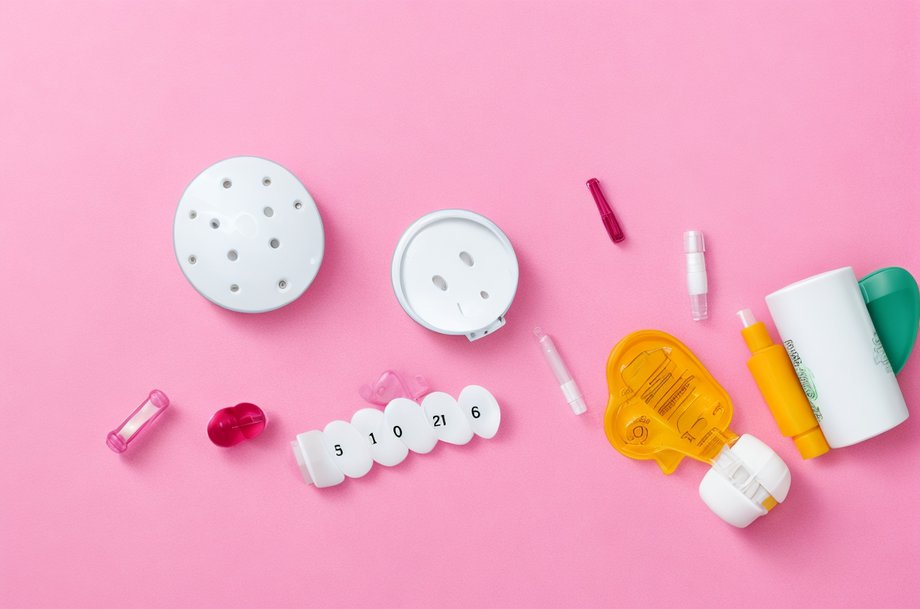What are Woman Contraception Types and Effectiveness

In today’s world, where women’s reproductive health is of utmost importance, it becomes crucial to explore the various types of contraception available to them.
From hormonal methods like pills and injections to barrier methods such as condoms and diaphragms, and even permanent methods like tubal ligation and hysterectomy, this article delves into the effectiveness of different contraception options.
By understanding and evaluating these methods, women can make informed decisions about their reproductive choices, serving their own needs while safeguarding their well-being.
Women’s Contraception Types Comparison Table
| Contraception Type | Effectiveness (Lowest Risk) | Short Description |
|---|---|---|
| Permanent Sterilization | Extremely Effective | Surgical procedures that permanently prevent pregnancy by blocking or cutting the fallopian tubes or vas deferens. |
| Intrauterine Device (IUD) | Extremely Effective | A small device inserted into the uterus, offering long-term contraception, some containing hormones, and others not. |
| Birth Control Implant | Extremely Effective | A tiny rod implanted under the skin that releases hormones to prevent pregnancy for up to several years. |
| Birth Control Shot | Very Effective | An injection of hormones administered every three months to prevent pregnancy. |
| Birth Control Pill | Very Effective | Daily oral medication containing hormones to regulate the menstrual cycle and prevent pregnancy. |
| Birth Control Patch | Very Effective | A patch worn on the skin that releases hormones to prevent pregnancy, changed weekly. |
| Vaginal Ring | Very Effective | A flexible ring inserted into the vagina, releasing hormones to prevent pregnancy, replaced monthly. |
| Diaphragm | Effective | A dome-shaped barrier device inserted into the vagina before sex to block sperm from reaching the cervix. |
| Cervical Cap | Effective | A smaller, cup-like barrier device similar to the diaphragm, placed over the cervix before intercourse. |
| Male Condom | Effective | A barrier sheath worn over the penis to prevent sperm from entering the vagina. |
| Female Condom | Effective | A polyurethane pouch inserted into the vagina before sex, providing a barrier to prevent pregnancy. |
| Withdrawal Method | Effective | The “pull-out” method, where the male withdraws the penis before ejaculation to prevent sperm from entering the vagina. |
| Fertility Awareness | Effective | Monitoring and tracking the menstrual cycle to avoid intercourse during fertile periods. |
| Sponge | Moderate | A soft, foam sponge with spermicide that is inserted into the vagina before sex. |
| Spermicide | Moderate | Chemical substances that kill or immobilize sperm, available in various forms, such as creams, gels, or foams. |
| No Method | Least Effective | No contraceptive method used, relying solely on chance to prevent pregnancy. |
Importance of Contraception for Women
Regularly utilizing contraception is of utmost importance for women as it allows them to have control over their reproductive health and make informed decisions about their future. The importance of consistent use cannot be overstated, as it ensures the effectiveness of contraception in preventing unintended pregnancies and reducing the risk of sexually transmitted infections.
Furthermore, long-term benefits can be derived from consistent and responsible contraceptive use. These benefits include improved family planning, reduced maternal and infant mortality rates, and increased educational and career opportunities for women.
Exploring Different Types of Contraception
One must consider the various types of contraception available, as they each have distinct advantages and potential side effects. When exploring different types of contraception, it is important to consider the benefits and drawbacks of each option.
For individuals who desire serving others, it is essential to be knowledgeable about non-hormonal options. Non-hormonal contraception methods offer alternatives to hormonal contraceptives, providing individuals with different choices that may better suit their needs and preferences.
Some non-hormonal options include barrier methods like condoms or diaphragms, intrauterine devices (IUDs) that do not contain hormones, or fertility awareness-based methods. These methods can be effective in preventing pregnancy without altering hormone levels in the body.
Being aware of the benefits and availability of non-hormonal contraception options ensures that individuals can make informed decisions about their reproductive health.
Hormonal Methods: Pills, Patches, and Injections
Hormonal methods such as pills, patches, and injections provide individuals with a variety of options for contraception. These methods work by altering hormone levels in the body to prevent pregnancy. While they are highly effective in preventing unwanted pregnancies, they do come with potential side effects.
It is important for individuals to be aware of these side effects and weigh them against the benefits of hormonal contraception. Common side effects include nausea, headaches, breast tenderness, and changes in menstrual bleeding. However, it is important to note that not everyone experiences these side effects, and they often subside over time.
It is recommended that individuals discuss their options with a healthcare professional to determine the best hormonal contraception method for their specific needs and to address any concerns about potential side effects.
Barrier Methods: Condoms and Diaphragms
When considering contraception options, it is essential to explore the effectiveness and benefits of barrier methods, such as condoms and diaphragms, in preventing pregnancy. These methods offer several advantages and disadvantages that should be taken into account:
Condoms
Pros:
- Provide protection against sexually transmitted infections (STIs)
- Easily accessible and affordable
- Can be used by both men and women
- No hormonal side effects
Cons:
-
- Requires consistent and correct use
- May decrease sensitivity
- Can break or slip off
Diaphragms
Pros:
- Can be inserted hours before sexual intercourse
- Can provide immediate protection
- No hormonal side effects
- Reusable and cost-effective
Cons:
- Requires proper fitting and insertion
- May increase the risk of urinary tract infections
- Can be messy to use
- Does not protect against STIs
Intrauterine Devices (IUDs): How They Work and Their Effectiveness
Intrauterine devices (IUDs) are highly effective contraceptives due to their ability to prevent fertilization and implantation of a fertilized egg within the uterus. These small, T-shaped devices are inserted into the uterus by a healthcare professional, providing a long-term contraception option for women.
The benefits of using IUDs are numerous. Firstly, they offer a high level of effectiveness, with a failure rate of less than 1%. Additionally, IUDs require minimal effort on the part of the user once inserted, providing continuous protection for several years. They are reversible and can be easily removed when desired. Moreover, IUDs do not interfere with sexual spontaneity or pleasure.
Overall, IUDs are a reliable and convenient contraceptive option for women seeking long-term protection.
Moving forward, let’s explore permanent methods such as tubal ligation and hysterectomy.
Permanent Methods: Tubal Ligation and Hysterectomy
While tubal ligation and hysterectomy are considered permanent methods of contraception, they differ in terms of their invasiveness and long-term effects on reproductive health.
Tubal ligation, also known as ‘getting your tubes tied,’ involves blocking or sealing the fallopian tubes to prevent eggs from reaching the uterus.
On the other hand, a hysterectomy is the surgical removal of the uterus.
Tubal ligation alternatives include non-surgical options like intrauterine devices (IUDs) or contraceptive implants, hormonal methods such as birth control pills or patches, barrier methods like condoms or diaphragms, and natural methods like fertility awareness or withdrawal.
Risks of hysterectomy include potential complications associated with surgery, loss of fertility and inability to bear children, hormonal changes and potential early menopause, and the emotional and psychological impact of losing the reproductive organs.
It is crucial to discuss these alternatives and risks with healthcare professionals to make informed decisions about contraception and reproductive health.
Effectiveness of Emergency Contraception
One effective option for preventing unintended pregnancies is emergency contraception, and it should be considered as part of a comprehensive approach to reproductive healthcare.
Emergency contraception, also known as the ‘morning-after pill,’ is a safe and highly effective method of preventing pregnancy after unprotected sex or contraceptive failure. It works by delaying or inhibiting ovulation, preventing fertilization, or altering the lining of the uterus to prevent implantation. Studies have shown that emergency contraception can reduce the risk of pregnancy by up to 95% when taken within 72 hours of unprotected sex.
However, despite its effectiveness, accessibility to emergency contraception remains a significant issue. Many women face barriers such as cost, lack of knowledge, limited access to healthcare providers, and stigma surrounding reproductive health.
It is crucial to address these barriers and ensure that emergency contraception is readily available to all women who need it. By improving access to emergency contraception, we can empower women to make informed choices about their reproductive health and prevent unintended pregnancies.
Frequently Asked Questions
Are There Any Non-Hormonal Methods of Contraception Available for Women?
There are several non-hormonal methods of contraception available for women. These include natural family planning methods such as the fertility awareness method, cervical mucus method, and withdrawal method. These options provide effective contraception without the use of hormones.
What Are the Potential Side Effects of Using Hormonal Methods of Contraception?
Potential risks of using hormonal contraception include mood changes, weight gain, and increased risk of blood clots. However, there are alternative non-hormonal methods available, such as barrier methods and intrauterine devices, that may be better suited to individual needs and preferences.
Can Women With Certain Medical Conditions or Allergies Use Hormonal Contraception?
Women with certain medical conditions or allergies may not be suitable candidates for hormonal contraception. It is important for them to consult with a healthcare professional to determine the most appropriate and safe contraceptive method for their specific situation.
How Effective Are Barrier Methods of Contraception in Preventing Pregnancy?
Barrier methods of contraception, such as condoms or diaphragms, offer an alternative to hormonal options. While they provide some protection against pregnancy, their effectiveness varies. Natural contraception methods, such as fertility awareness, can also be considered, but they require careful monitoring and have a higher failure rate.
Are There Any Long-Term Consequences of Using Intrauterine Devices (Iuds) for Birth Control?
Long-term effects of using intrauterine devices (IUDs) for birth control include a small risk of pelvic inflammatory disease and ectopic pregnancy. However, the overall benefits of IUDs in preventing pregnancy outweigh these potential risks.
Key Takeaways
- Contraception allows women to have control over their reproductive health and make informed decisions about their future.
- Non-hormonal methods of contraception offer alternatives to hormonal contraceptives and prevent pregnancy without altering hormone levels.
- Hormonal methods of contraception are highly effective in preventing unwanted pregnancies but may have potential side effects that vary among individuals.
- Barrier methods of contraception, such as condoms and diaphragms, provide protection against sexually transmitted infections and have no hormonal side effects.








